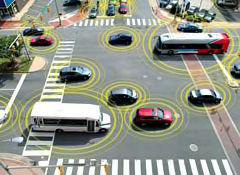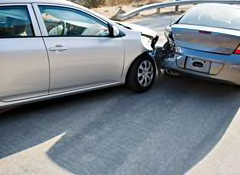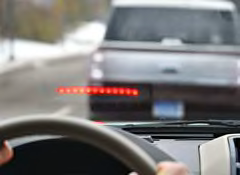Two Consumer Reports staffers got to experience V2X technology firsthand. Reporter Liza Barth attended one of NHTSA's driver clinics in Alameda, Calif. She drove eight V2X-equipped vehicles from different automakers to see how the technology helps in scenarios such as passing on a road when there's an oncoming car, detecting vehicles in a car's blind spot, and avoiding a driver who's running a red light. Tom Mutchler, our Auto Test Center's human-factors engineer, got to see Ford's Intelligent Intersection in Dearborn, Mich., and how vehicles can communicate with roadside infrastructure as well as other vehicles.
Overall, they both came away impressed with the effectiveness and potential safety benefits of the systems.
All of the vehicles that Barth drove received the same type of speed and location data from other vehicles. They differed only in how they alerted the driver about potential crashes. She found the display in the Ford and Mercedes-Benz cars to be the most effective. They use a bright band of lights on the dash that reflect in the windshield, coupled with a warning sound. A yellow light signals a potential hazard, and a red light warns that action, such as braking, needs to occur immediately. This is similar to the type of alert used in many of today's forward-collision warning systems. The location of the lights made it easy to see as she looked through the windshield.
Other manufacturers use an audible alert along with some kind of warning icon, short message (such as "Do not pass"), and/or graphic. General Motors and Toyota display the information above the center stack. Hyundai illustrates the warning in the center navigational display. Honda, Nissan, and Volkswagen show their visual warning in the instrument cluster, which is easier to miss.
"No matter how the visual alert is displayed, the loud beeping noise immediately gets your attention," Barth says.
In addition to audible and visual alerts, Ford's and GM's cars use vibrations in the seat cushion. It's a directional alert, so the side of the cushion that vibrates represents the side of the vehicle that is in danger. "Feeling the vibration quickly draws your attention to the hazard," Barth says.
A red-light warning from your car
Mutchler saw a demonstration of Ford's Intelligent Intersection while riding in a Ford Escape Hybrid. In addition to witnessing vehicle-to-vehicle demonstrations, he also got to see how infrastructure can aid such a system.
The intersection's traffic signal is able to transmit data to the Escape, including a detailed map of the intersection, the status of the light (red, yellow, or green), and a correction factor for the vehicle's GPS. This reduces the GPS's margin of error, allowing the system to know what lane the car is in. That is important for intersections with turn arrows or other lane-specific signals.
With the data, a car can warn a driver who is about to run a red light. Ford's engineers demonstrated this as they drove toward the intersection without braking. "Red light!" announced the Escape, and a bright strip of lights on the dash flashed, prompting the driver to screech to a stop.
The infrastructure demands of a smart intersection are modest—just the transmitter, a GPS antenna, and a data feed from the signal control. There's no need to dig up the roadway. The transmitter can also provide map information for multiple stop-sign intersections in the same area. Similar to the red-light experience, the Escape warned the driver when he was about to go through a stop sign at multiple adjacent intersections.























